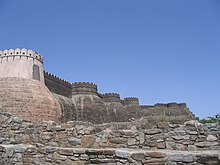Kumbhalgarh Fort
|
Kumbhalgarh कुंभलगढ़ Kumbhalmer, Kumbalgarh |
|
|---|---|

The walls of the fort of Kumbhalgarh extend over 38 km, claimed to be the second-longest continuous wall after the Great Wall of China.
|
|
| Location in Rajasthan, India | |
| Coordinates: 25°08′51″N 73°34′59″E / 25.1475°N 73.5831°ECoordinates: 25°08′51″N 73°34′59″E / 25.1475°N 73.5831°E | |
| Country |
|
| State | Rajasthan |
| District | Rajsamand |
| Elevation | 1,100 m (3,600 ft) |
| Languages | |
| • Official | Hindi |
| Time zone | IST (UTC+5:30) |
| Vehicle registration | RJ 30 |
| Website | www |
 |
|
| UNESCO World Heritage Site | |
|---|---|
| Location |
Rajsamand district, India |
| Coordinates | 25°08′51″N 73°34′59″E / 25.1475°N 73.5831°E |
| Criteria | ii, iii |
| Reference | 247 |
| Inscription | 2013 (36th Session) |
|
[]
|
|
Kumbhalgarh ("Kumbhal fort") is a Mewar fortress on the westerly range of Aravalli Hills, in the Rajsamand district near Udaipur of Rajasthan state in western India. It is a World Heritage Site included in Hill Forts of Rajasthan. Built during the course of the 15th century by Rana Kumbha, Kumbhalgarh is also the birthplace of Maharana Pratap, the great king and warrior of Mewar. Occupied until the late 19th century, the fort is now open to the public and is spectacularly lit for a few minutes each evening. Kumbalgarh is situated 82 km northwest of Udaipur by road. It is the most important fort in Mewar after Chittaurgarh.
In 2013, at the 37th session of the World Heritage Committee held in Phnom Penh, Cambodia, Kumbhalgarh Fort, along with five other forts of Rajasthan, was declared a UNESCO World Heritage Site under the group Hill Forts of Rajasthan.
With a wall over 38 km long, the fort is among the largest wall complex in the world, and the second largest fort in Rajasthan after Chittorgarh Fort.
The early history of the fort could not be ascertained on account of lack of evidence. The earliest name of the fort is believed to be Machhindrapur, while Sahib Haqim, a historian, named it Mahore. The original fort is believed to have been built by King Samprati of the Maura Age on account of the strategic importance during the 6th century. The subsequent history till 1303 AD till the invasion of Alauddin Khilji is obscure.
Kumbhalgarh in its current form was built and ruled by Rana Kumbha and his dynasty who were Hindu Sisodia rajputs descendents. Kumbhalgarh in its present form was developed by, and believed to have been designed by a famous architect of the era Madan. Rana Kumbha's kingdom of Mewar stretched from Ranthambore to Gwalior and included large tracts of erstwhile Madhya Pradesh as well as Rajasthan. Out of the 84 forts in his dominion, Rana Kumbha is said to have designed 32 of them, of which Kumbhalgarh is the largest and most elaborate.
...
Wikipedia



